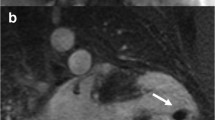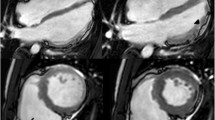Abstract
Cardiac MRI (CMR) and electrocardiogram (ECG)-gated multi-detector computed tomography (MDCT) are increasingly important tools in the identification and assessment of cardiac-related disease processes, including those associated with sudden cardiac death (SCD). While the commonest cause of SCD is coronary artery disease (CAD), in patients under 35 years inheritable cardiomyopathies such as hypertrophic cardiomyopathy and arrhythmogenic right ventricular cardiomyopathy are important aetiologies. CMR in particular offers both accurate delineation of the morphological abnormalities associated with these and other conditions and the possibility for risk stratification for development of ventricular arrhythmias with demonstration of macroscopic scar by delayed enhancement imaging with intravenous gadolinium.






Similar content being viewed by others
References
Priori SG, Aliot E, Blomstrom-Lundqvist C et al (2003) Update of the guidelines on sudden cardiac death of the European Society of Cardiology. Eur Heart J 24:13–15
Myerburg RJ, Castellanos A (2001) Cardiac arrest and sudden cardiac death. WB Saunders, Philadelphia
Kirchhof P, Breithardt G, Eckardt L (2006) Primary prevention of sudden cardiac death. Heart 92:1873–1878
Zheng ZJ, Croft JB, Giles WH et al (2001) Sudden cardiac death in the United States, 1989 to 1998. Circulation 104:2158–2163
Doolan A, Langlois N, Semsarian A (2004) Causes of sudden cardiac death in young Australians. Med J Aust 180:110–112
Wisten A, Forsberg H, Krantz P et al (2002) Sudden cardiac death in 15–35-year olds in Sweden during 1992–1999. J Intern Med 2552:529–536
Chugh SS, Senashova O, Watts A et al (2004) Post mortem molecular screening in unexplained sudden death. J Am Coll Cardiol 43:1625–1629
Olson TM, Michels VV, Thibodeau SN et al (1998) Actin mutations in dilated cardiomyopathy, a heritable form of heart failure. Science 280:750–752
Monserrat L, Hermida-Prieto M, Fernandez X et al (2007) Mutation in the alpha-cardiac actin gene associated with apical hypertrophic cardiomyopathy, left ventricular non-compaction, and septal defects. Eur Heart J 28:1953–1961
Olson TM, Doan TP, Kishimoto NY et al (2000) Inherited and de novo mutations in the cardiac actin gene cause hypertrophic cardiomyopathy. J Mol Cell Cardiol 32:1687–1694
Maron BJ, Towbin JA, Thiene G et al (2006) Contemporary definitions and classification of the cardiomyopathies: An American Heart Association Scientific Statement from the Council on Clinical Cardiology, Heart Failure and Transplantation Committee; Quality of Care and Outcomes Research and Functional Genomics and Translational Biology Interdisciplinary Working Groups; and Council on Epidemiology and Prevention. Circulation 113:1807–1816
Marian AJ, Roberts R (2001) The molecular genetic basis for hypertrophic cardiomyopathy. J Mol Cell Cardiol 33:655–670
Niimura H, Bachinski LL, Sangwatanaroj S et al (1998) Mutations in the gene for cardiac myosin-binding protein C and late-onset familial hypertrophic cardiomyopathy. N Engl J Med 338:1248–1257
Maron BJ, Olivotto I, Spirito P et al (2000) Epidemiology of hypertrophic cardiomyopathy related death: revisited in a large non-referral-based patient population. Circulation 102:858–864
Hughes SE (2004) The pathology of hypertrophic cardiomyopathy. Histopathology 44:412–427
Choudry L, Mahrholdt H, Wagner A et al (2002) Myocardial scarring in asymptomatic or mildly symptomatic patients with hypertrophic cardiomyopathy. J Am Coll Cardiol 40:2156–2164
Shirani J, Pick R, Roberts WC et al (2000) Morphology and significance of the left ventricular collagen network in young patients with hypertrophic cardiomyopathy and sudden cardiac death. J Am Coll Cardiol 35:36–44
Elliott PM, Gimeno Blanes JR, Mahon NG et al (2001) Relation between severity of left-ventricular hypertrophy and prognosis in patients with hypertrophic cardiomyopathy. Lancet 357:420–424
Tanaka M, Fujiwara H, Onodera T et al (1986) Quantitative analysis of myocardial fibrosis in normals, hypertensive hearts, and hypertrophic cardiomyopathy. Br Heart J 55:575–581
Kwon DH, Setser RM, Zoran B et al (2008) Association of myocardial fibrosis, electrocardiography and ventricular tachyarrhythmia in hypertrophic cardiomyopathy: a delayed contrast enhanced MRI study. Int J Cardiovasc Imaging 24(6):617–625, Epub 2008 Jan 19
Moon JC, McKenna WJ, McCrohon JA et al (2003) Toward clinical risk assessment in hypertrophic cardiomyopathy with gadolinium cardiovascular magnetic resonance. J Am Coll Cardiol 41:1561–1567
Teraoka K, Hirano M, Ookubo H et al (2004) Delayed contrast enhancement of MRI in hypertrophic cardiomyopathy. Magn Reson Imaging 22:155–161; erratum in Magn Reson Imaging (2004) 2022:2901
Adabag AS, Maron BJ, Appelbaum E et al (2008) Occurrence and frequency of arrhythmias in hypertrophic cardiomyopathy in relation to delayed enhancement on cardiovascular magnetic resonance. J Am Coll Cardiol 51:1369–1374
Pelliccia A, Culasso F, Di Paolo F et al (1999) Physiologic left ventricular cavity dilatation in elite athletes. Ann Intern med 130:23–31
Petersen SE, Selvanayagam JB, Francis JM et al (2005) Differentiation of athlete’s heart from pathological forms of hypertrophy by means of geometric indices derived from cardiovascular magnetic resonance. J Cardiovasc Magn Reson 7:551–558
Maceira AM, Joshi J, Prasad SK et al (2005) Cardiovascular magnetic resonance in cardiac amyloidosis. Circulation 111:186–193
Sachdev B, Takenaka T, Teraguchi H et al (2002) Prevalence of Anderson-Fabry disease in male patients with late onset hypertrophic cardiomyopathy. Circulation 105:1407–1411
Shah JS, Hughes DA, Sachdev B et al (2005) Prevalence and clinical significance of cardiac arrhythmia in Anderson-Fabry disease. Am J Cardiol 96:842–846
Moon JC, Sachdev B, Elkington AG et al (2003) Gadolinium enhanced cardiovascular magnetic resonance in Anderson-Fabry disease: evidence for a disease specific abnormality of the myocardial interstitium. Eur Heart J 24:2151–2155
Alcalai R, Metzger S, Rosenheck S et al (2003) A recessive mutation in desmoplakin causes arrhythmogenic right ventricular dysplasia, skin disorder, and woolly hair. J Am Coll Cardiol 42:319–327
McKoy G, Protonotarios N, Crosby A et al (2000) Identification of a deletion in plakoglobin in arrhythmogenic right ventricular cardiomyopathy with palmoplantar keratoderma and woolly hair (Naxos disease). Lancet 355:2119–2124
Rampazzo A, Nava A, Malacrida S et al (2002) Mutation in human desmoplakin domain binding to plakoglobin causes a dominant form of arrhythmogenic right ventricular cardiomyopathy. Am J Hum Genet 71:1200–1206
Sen-Chowdry S, Lowe MD, Sporton SC et al (2004) Arrhythmogenic right ventricular cardiomyopathy: clinical presentation, diagnosis and management. Am J Med 117:685–695
Sen-Chowdhry S, Syrris P, Ward D et al (2007) Clinical and genetic characterization of families with arrhythmogenic right ventricular dysplasia/cardiomyopathy provides novel insights into patterns of disease expression. Circulation 115:1710–1720
McKenna WJ, Thiene G, Nava A et al (1994) Diagnosis of arrhythmogenic right ventricular dysplasia/cardiomyopathy. Task Force of the Working Group Myocardial and Pericardial Disease of the European Society of Cardiology and of the Scientific Council on Cardiomyopathies of the International Society and Federation of Cardiology. Br Heart J 71:215–218
Sen Chowdhry S, Prasad SK, Petros S et al (2006) Cardiovascular magnetic resonance in arrythmogenic right ventricular cardiomyopathy revisited. J Am Coll Cardiol 48:2132–2140
Hamid MS, Norman M, Queraishi A et al (2002) Prospective evaluation of relatives for familial Arrhythmogenic right ventricular cardiomyopathy/dysplasia reveals a need to broaden diagnostic criteria. J Am Coll Cardiol 40:1445–1450
Jaoude SA, Leclercq JF, Coumel P (1996) Progressive ECG changes in arrhythmogenic right ventricular disease. Evidence for an evolving disease. Eur Heart J 17:1717–1722
Tandri H, Macedo R, Calkins H et al (2008) Role of magnetic resonance imaging in arrhythmogenic right ventricular dysplasia: Insights from the North American arrhythmogenic right ventricular dysplasia (ARVD/C) study. Am Heart J 155:147–153
Bluemke DA, Krupinski EA, Ovitt T et al (2003) MR Imaging of arrhythmogenic right ventricular cardiomyopathy: morphologic findings and interobserver reliability. Cardiology 99:153–162
Burke AP, Farb A, Tashko G et al (1998) Arrhythmogenic right ventricular cardiomyopathy and fatty replacement of the right ventricular myocardium: are they different diseases? Circulation 97:1571–1580
Tandri H, Saranthan M, Rodriguez ER et al (2005) Noninvasive detection of myocardial fibrosis in arrhythmogenic right ventricular cardiomyopathy using delayed-enhancement magnetic resonance imaging. J Am Coll Cardiol 45:98–103
Kimura F, Sakai F, Sakomura Y et al (2002) Helical CT features of arrhythmogenic right ventricular cardiomyopathy. Radiographics 22:1111–1124
Bomma C, Tandri H, Nasir K et al (2003) Role of helical CT in qualitative and quantitative evaluation of arrhythmogenic right ventricular dysplasia. Pacing Clin Electrophysiol 26:965
Ritter M, Oechslin E, Sutsch G et al (1997) Isolated noncompaction of the myocardium in adults. Mayo Clin Proc 72:26–31
Ichida F, Tsubata S, Bowles KR et al (2001) Novel gene mutations in patients with left ventricular noncompaction or Barth syndrome. Circulation 103:1256–1263
Sasse-Klaassen S, Gerull B, Oechslin E et al (2003) Isolated noncompaction of the left ventricular myocardium in the adult is an autosomal dominant disorder in the majority of patients. Am J Med Genet 119A:162–167
Oechslin EN, Attenhofer Jost CH, Rojas JR et al (2000) Long-term follow-up of 34 adults with isolated left ventricular noncompaction: a distinct cardiomyopathy with poor prognosis. J Am Coll Cardiol 36:493–500
Petersen SE, Selvanayagam JS, Wiesmann F et al (2005) Left ventricular non-compaction: insights from cardiovascular magnetic resonance imaging. J Am Coll Cardiol 46:101–105
Murphy RT, Thaman R, Blanes JG et al (2004) Natural history and familial characteristics of isolated left ventricular non-compaction. Eur Heart J 26:187–192
Angelini P, Velasco JA, Flamm S (2002) Coronary anomalies: incidence, pathophysiology, and clinical relevance. Circulation 105:2449–2454
Burke AP, Farb A, Virmani R et al (1991) Sports-related and non-sports-related sudden cardiac death in young adults. Am Heart J 121:568–575
Maron BJ, Thompson PD, Puffer JC et al (1996) Cardiovascular preparticipation screening of competitive athletes: a statement for health professionals from the Sudden Death Committee (Clinical Cardiology) and Congenital Cardiac Defects Committee (Cardiovascular Disease in the Young), American Heart Association. Circulation 94:850–856
Moustafa SE, Zehr K, Mookadam M et al (2007) Anomalous interarterial left coronary artery: An evidence based systematic overview. Int J Cardiol 126(1):13–20, Epub 2007 Aug 14
Angelini P, Villason S, Chan AV et al (1999) Normal and anomalous coronary arteries in humans. In: Angelini P (ed) Coronary artery anomalies: a comprehensive approach. Lippincott Williams & Wilkins, Philadelphia, pp 27–150
Author information
Authors and Affiliations
Corresponding author
Rights and permissions
About this article
Cite this article
Sparrow, P., Merchant, N., Provost, Y. et al. Cardiac MRI and CT features of inheritable and congenital conditions associated with sudden cardiac death. Eur Radiol 19, 259–270 (2009). https://doi.org/10.1007/s00330-008-1169-5
Received:
Revised:
Accepted:
Published:
Issue Date:
DOI: https://doi.org/10.1007/s00330-008-1169-5




